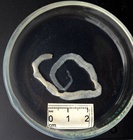WoRMS taxon details
Cestoda
- Subclass Cestodaria
- Subclass Eucestoda
- Genus Dubium Rudolphi, 1819 (uncertain > nomen dubium, erected as a collective group name for parasites that could not be classified)
marine, brackish, fresh, terrestrial
Not documented
WoRMS (2025). Cestoda. Accessed at: https://www.marinespecies.org/aphia.php?p=taxdetails&id=1051 on 2025-03-28
Date
action
by
2004-12-21 15:54:05Z
created
db_admin
![]() The webpage text is licensed under a Creative Commons
Attribution 4.0 License
The webpage text is licensed under a Creative Commons
Attribution 4.0 License
Identification resource
identification resource
Chervy, L. (2024). Manual for the study of tapeworms (Cestoda) parasitic in ray-finned fish, amphibians and reptiles. <em>Folia Parasitologica.</em> 71., available online at https://doi.org/10.14411/fp.2024.001 [details]
identification resource Jones, A., Bray, R.A., Khalil, L.F. (1994). Key to the orders of the Cestoda. In: Khalil, L.F., Jones, A. & Bray, R.A. [Editors]. <em>Keys to the cestode parasites of vertebrates.</em> Wallingford: CAB International, 1-2.
page(s): 1 [details]
identification resource Jones, A., Bray, R.A., Khalil, L.F. (1994). Key to the orders of the Cestoda. In: Khalil, L.F., Jones, A. & Bray, R.A. [Editors]. <em>Keys to the cestode parasites of vertebrates.</em> Wallingford: CAB International, 1-2.
page(s): 1 [details]
Other
context source (PeRMS)
Luque, J.L., C. Cruces, J. Chero, F. Paschoal, P.V. Alves, A.C. Silva, L. Sanchez & J. Iannacone. (2016). Checklist of metazoan parasites of fishes from Peru. Lista de verificación de los metazoos parásitos de peces de Perú. <em>Neotropical Helminthology.</em> 10(2), jul-dic: 301-375. [details] Available for editors  [request]
[request]
additional source Waeschenbach, A.; Webster, B. L.; Bray, R. A.; Littlewood, D. (2007). Added resolution among ordinal level relationships of tapeworms (Platyhelminthes: Cestoda) with complete small and large subunit nuclear ribosomal RNA genes. <em>Molecular Phylogenetics and Evolution.</em> 45(1): 311-325., available online at https://doi.org/10.1016/j.ympev.2007.03.019
page(s): 311 [details]
additional source Waeschenbach, A.; Webster, B. L.; Bray, R. A.; Littlewood, D. (2007). Added resolution among ordinal level relationships of tapeworms (Platyhelminthes: Cestoda) with complete small and large subunit nuclear ribosomal RNA genes. <em>Molecular Phylogenetics and Evolution.</em> 45(1): 311-325., available online at https://doi.org/10.1016/j.ympev.2007.03.019
page(s): 311 [details]
 Present
Present  Inaccurate
Inaccurate  Introduced: alien
Introduced: alien  Containing type locality
Containing type locality
From editor or global species database
Classification The classification used here is a compromise between the more traditional taxonomy of Neodermata vs. the turbellarians. Yet it reflects the fact that Neodermata is within free-living flatworms (i.e. turbellaria are paraphyletic). It mentions all traditional taxa that are found in phylogenetic studies (e.g. Laumer et al., 2015). Many of the "in-between" higher level taxa (such as Trepaxonemata etc.) are no longer in WoRMS (probably more user friendly that way). This also means an asymmetry between turbellarians (nine ordines) and Neodermata (superclass with three classes). [details]
| Language | Name | |
|---|---|---|
| Dutch | lintwormen | [details] |
| English | tapewormscestodes | [details] |
| German | CestodenBandwürmer | [details] |
| Japanese | 条虫綱 | [details] |
| Swedish | bandmaskar | [details] |


